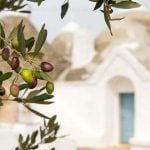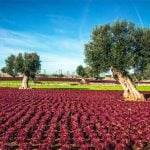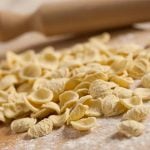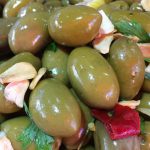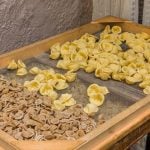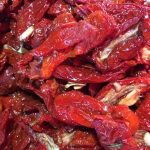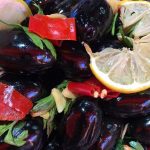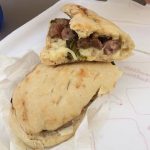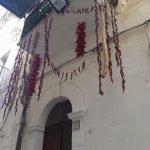Apulia - Food and Wine
Apulia is often defined as the land of wonders, a blend of art and culture, ancient customs and an impressive culinary tradition that is able to conquer the hearts of those who set foot in this territory. The landscape is defined by a smooth transition between the coast, dominated by limestone reliefs and paradise-like beaches, and the inland is characterized by the presence of beautiful olive groves.
The region is predominantly agricultural and it is famous around the world for its unique olive oil, high-quality wine, grains, and citrus fruits.
For many, Apulia is synonymous with olive trees and stone mills. Olive oil is considered to be the gold of the region, the result of great work and dedication by those who, with love and respect, cultivate and care for the olive trees. For the locals, every drop of olive oil is precious and embodies a unique and fresh flavor.
Without a doubt, the most appreciated types of olive oil are the DOP varieties, present throughout the territory. Among them, probably the most famous is Collina di Brindisi, a DOP extra virgin olive oil produced in the province of Brindisi.
In the province of Foggia, the Dauno DOP extra virgin olive oil is the most appreciated. This olive oil, made from local olive varieties such as Garganica or Rotondella, has a distinctive sweet and harmonious taste and it pairs perfectly with fish and seafood appetizers.
Terra di Bari and Terra D’Otranto are other famous DOP extra virgin olive oils produced from local olive varieties in the provinces of Bari and Lecce, respectively.
The sun of the South also favors the cultivation of citrus fruits, and in Apulia, it is easy to come across citrus tree orchards that, especially during autumn and winter, impress with their sweet perfumes and vibrant colors.
The citrus cultivation has increased above all in the area of Salento, mostly in the province of Lecce, where the orchards occupy around 7,000 acres of land. The most commonly cultivated citrus fruits are oranges, with the clear favorite being the Navelina.
Tangerines are not particularly famous in Apulia, but the region has something better, the Clementine from the Gulf of Taranto, a unique hybrid that is characterized by a sweet and juicy pulp and, for the most part, the absence of seeds.
Lemons are easily found in the Gargano area and among the unique local varieties, we can mention the Femminiello, Monachello, and Interdonato.
Appetizers
Apulia’s cuisine is made from ancient flavors with a respect for the seasons. The traditional dishes are divided between the inland and coastal areas, and they bare different influences that vary from one city to another.
One of the most popular appetizers in the region is acquasale, a dish that in the past was served as lunch to fishermen and peasants. The appetizer is prepared either with stale bread or with friselle, a local type of twice-baked bread, that is garnished with a mixture of onion, tomatoes, salt, oregano, eggs, extra virgin olive oil, and water.
Cured meats are also a popular appetizer and local varieties include Capocollo di Martina Franca, a type of salami made exclusively with meat from a breed of pigs raised in the Valle d’Itria area. Prosciutto di Faeto and Lardo di Faeto are other popular cured meats served as appetizers, especially in the province of Foggia. Another specialty in Foggia is muschiska, lamb, goat, or veal meat that is seasoned with hot peppers, fennel seeds, salt, and garlic and dried in the sun for 15 to 20 days.
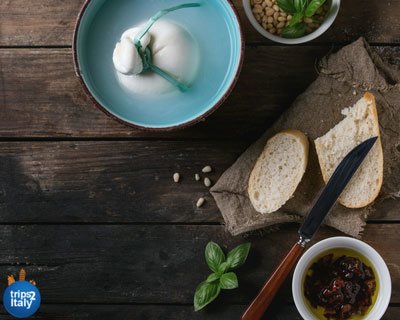 As appetizers, we can also mention a wide variety of cheeses. Among them, probably the most appreciated by the locals is caciocavallo podolico, a type of semi-hard cheese made from the milk produced by a breed of cow found only in southern Italy. The cheese is typically aged in caves or wells and it has a spicy taste featuring wild herbs.
As appetizers, we can also mention a wide variety of cheeses. Among them, probably the most appreciated by the locals is caciocavallo podolico, a type of semi-hard cheese made from the milk produced by a breed of cow found only in southern Italy. The cheese is typically aged in caves or wells and it has a spicy taste featuring wild herbs.
Pallone di Gravina is another type of semi-hard cheese typical of Apulia and made from bovine milk. Produced in the city of Gravina as well as the nearby region of Basilicata, the cheese has a round shape and is usually produced between January and March. The cheese is consumed either fresh or aged for up to four months, and during this time it assumes a slight spicy note.
In the province of Bari, the most famous cheese is without a doubt Burrata d’Andria, a fresh cheese with an exterior similar to mozzarella and a soft, buttery interior.
Cacioricotta is another type of cheese famous throughout the Apulia region. Usually made from goat or sheep milk, cacioricotta is consumed fresh or aged for about three months to develop a tangy flavor. The cheese is produced in all seasons but the best time to taste it is in late spring or early summer.
Lastly, a cheese worth mentioning is canestrato pugliese, which is typical of the areas of Foggia and Bari and is obtained from whole milk produced by a specific breed of sheep that is fed exclusively with fresh herbs. The cheese is aged for at least 90 days and is consumed with fruits and vegetables, or it is used to garnish pasta dishes or salads.
Typically, cured meats in Apulia are served with bread or taralli. In Apulia, bread has ancient traditions and there are many different types of bread that must be tasted throughout the region. In the province of Foggia, pane di Monte Sant’Angelo is probably the most famous, while Altamura, in the province of Bari, is another area renowned for its exquisite bread, which is made from re-milled durum wheat.
Taralli, on the other hand, are a simple product originally prepared by peasants and served with a glass of wine. The texture of taralli is similar to the breadstick and, according to tradition, they were originally made from leftover bread dough enriched with white wine and water. Today, these ring-shaped crackers represent the perfect finger food that pairs well with all types of cured meats and cheeses.
Another unique appetizer from the area is known as peperoncini ripieni sott’olio, Following the traditional recipe, round chili peppers are boiled in a mixture of vinegar and wine then stuffed with tuna and capers and finally preserved in a jar filled with extra virgin olive oil.
First Course
The agricultural tradition of the region led to dishes inspired by local products. For instance, the Apulians have a special love for beans, which they use to make soups in the winter and salads during the summer. Furthermore, beans can be added to many pasta dishes or transformed in purees.
The locals also make use of many wild vegetables, such as rapini, chicory, and dandelion that are first boiled then seasoned with olive oil and served alone or as part of a dish.
Soups vary a lot between the coastal regions and the inland areas. In the coastal regions, fish soups are the first courses of choice, the most famous being zuppa gallipolina, made with several different types of seafood including scorpionfish, gurnard, grouper, cuttlefish, and mussels, as well as zuppa brindisina, which features scorpionfish, squid, cuttlefish, mussels, and clams. 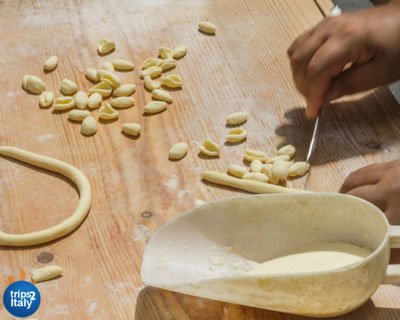 Additionally, the Bari area is well-known for octopus stew and octopus skewers.
Additionally, the Bari area is well-known for octopus stew and octopus skewers.
Inland areas, on the other hand, boast typical soups linked to the peasant tradition, made with simple ingredients that have heavenly tastes. Among them, cialledda is one of the most popular, and it is made with stale bread, tomatoes, onions, oregano, and parsley.
In the province of Bari, a popular dish is the minestra verde, which is traditionally served on St. Stephen's Day, and is literally a green soup made with cardoon, fennel, endive, cabbage, cauliflower, chicory and other leafy vegetables as well as pieces of boiled meat (beef, pork, veal, chicken, or turkey).
Furthermore, the Apulia region boasts an impressive variety of types of pasta. Among them, the most beloved by the locals are the orecchiette, a type of short pasta shaped like a small ear. Orecchiette con cime di rapa (orecchette with broccoli rabe) is, without a doubt, the signature dish of the region.
Another type of short pasta that is typical of the region is called Cavatelli, with some local variations referred to using different names, such as pizzicarieddi. In Apulia, this short pasta is typically served with tomatoes, arugula and sometimes burrata. Another delicious pasta dish present throughout southern Italy, including in Apulia, is timballo, which is a baked dish that features layers of ziti, ground beef, local cheese, pork belly, and breadcrumbs.
Long pasta, such as spaghetti, troccoli or vermicelli, is often accompanied by a simple tomato sauce, lentils, or in-season vegetables.
Another popular first course in Apulia is known as tiella barese. A baked dish featuring, rice, potatoes, mussels and breadcrumbs, tiella barese is native to the province of Bari, however it can be prepared almost anywhere in the region with each family having a unique recipe.
Main Course
Similar to the first courses, the main courses differ between the coastal areas and the inland. As you could expect, the coastal areas offer fish and seafood dishes made with the exquisite fish local to the region. Among them, one of the tastiest is cozze ripiene. Following the traditional preparation of this dish, mussels are stuffed with softened bread crumbs, chopped parsley, pecorino, and then cooked with tomatoes and garlic.
Gamberoni al guazzetto is another appetizing main course that exalts the simplicity of Apulian cuisine. The dish is made with prawns cooked in a sauce featuring tomatoes, garlic, and brandy, and usually served with a generous amount of bread.
In the Salento area, scapece gallipolina is a simple, historic dish made with small local fish (up to 4 inches long) that are fried then marinated between layers of breadcrumbs and soaked in vinegar and saffron. The dish is prepared inside of wooden tubs called calette.
Apulian baccalà, which is dried and salted cod, is another fish-based main course, popular in the region especially during the winter.
Apart from these dishes, in the coastal areas, locals prepare a wide variety of broiled or grilled fish in very simple ways often accompanied by in-season vegetables.
In the inland areas of Apulia, meat is the protagonist of the main dishes and it is prepared following countless methods that vary from stews to grilled meat, to skewers and roast.
Among all dishes, braciole pugliesi is one that stands out. These veal rolls are stuffed with pecorino or canestrato pugliese cheese as well as pancetta and parsley, then slowly cooked in tomato sauce, resulting in meat that is tender and delicious.
The bombette pugliesi are another popular main dish in Apulia, above all in the Murgia and Bari areas. These rolls of veal are stuffed with caciocavallo cheese and sometimes wrapped in pancetta. Typically the rolls are placed on skewers then grilled, but they can also be roasted in the oven. Because of their tiny dimensions, bombette pugliesi are also a popular street food.
An exquisite main dish popular in almost all areas of Apulia is torcinelli, a unique type of sausage made of long slices of lamb or kid lung, heart, liver, and kidney, which are wrapped in the animal’s gut. The sausages are usually grilled but they can be cooked in many ways, including in ragù.
Apulia also boasts exquisite vegetarian dishes. One of them is called fave e cicoria, which consists of pureed fava beans served with chicory. Additionally, Apulian cuisine tends to feature vegetables that may not be as well known outside of the region, such as the tassel hyacinth, called lampascioni by the locals, which can be served grilled, fried, or boiled and seasoned simply with black pepper, salt, vinegar, and olive oil.
Lastly, the bread dumplings, called polpette di pane in the local language, are a “poor” dish of the peasant tradition featuring stale bread, cheese, parsley, and eggs to create an exquisite main course. The dumplings are usually fried in extra virgin olive oil until golden brown.
Side Dishes
In Apulia, side dishes are usually “poor,” made with simple ingredients that can perfectly exalt the flavor of the main courses.
Pomodori arraganati is one of the most popular side dishes in the Apulian gastronomic tradition. The dish is made of tomatoes that are usually stuffed with bread crumbs, anchovies, capers, parsley and basil, then baked in the oven and served with fish dishes or as an appetizer.
'Ncapriata is one of the sides of choice for the meat dishes. This side is made with fava beans that are slowly cooked in salted water with garlic and hot peppers. Depending on the preferences, they can be served as a puree or whole beans, and are usually accompanied by sautéed rapini or chicory.
Apart from these dishes, there are wide varieties of vegetable dishes that include grilled or sautéed vegetables, purees of vegetables or beans, and baked vegetables.
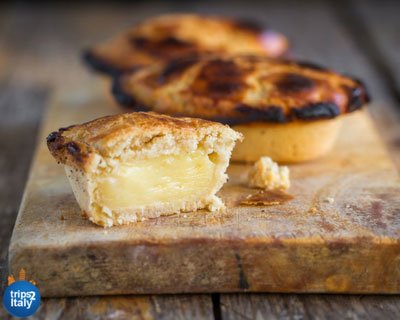
Desserts
Apulia boasts numerous delicious desserts that can complete any meal. Just as the above-mentioned dishes, Apulian desserts have their roots deepened in the local tradition and tied to celebrations or holidays.
One exception that is enjoyed all year round is known as sporcamuss (which means "dirty face" in the local dialect, due to the messy nature of the dessert). This simple dessert consists of puff pastry filled with a rich cream. In some cases, sporcamuss may also be filled with jam or pieces of strawberry. No matter the filling, this delicious treat is always served hot and topped with a generous layer of powdered sugar, the key ingredient from which the dessert's unique name arises.
Traditional in the Christmas season, especially in the province of Foggia, the cartellate are another exquisite local dessert. This sweet treat is made of flour, white wine, and olive oil. The dough is shaped as a ribbon with pointed edges then swirled into a spiral. After the cartellate are fried, they can be covered in honey or soaked in vincotto (a thick, sweet paste made from grape must).
Biscotti di Ceglie are a type of cookie made of almond flour that are filled with cherry or grape marmalade. These rustic cookies were traditionally enjoyed by the peasant families of the town of Ceglie Messapica.
In the Gargano area, ostie ripiene is another type of dessert that can literally delight everyone. This sweet is made of two thin sheets of wafer stuffed with caramelized toasted almonds and honey.
Lastly, pasticciotto is a sweet typical in the Salento region, made of pastry and filled with custard. These decadent sweets can be enjoyed for breakfast or throughout the day and are a staple in Apulia’s pasticcerie.
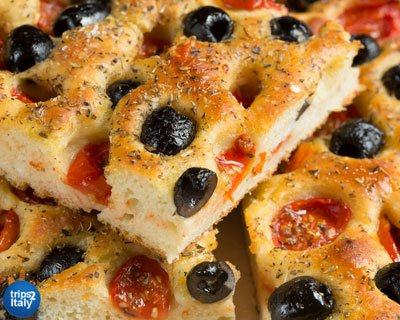
Street Food
Without a doubt, the center of the street food in Apulia is Bari and the towns in the province of Bari. There are countless delicacies to taste on the go in this area.
Focaccia barese is certainly the most popular type of street food. Focaccia can be found in other parts of Italy as well, most notably in Liguria, the region from which this dish originates. The peculiarity of Bari's version of this type of flat bread is the presence of potatoes in the dough. The focaccia is baked in round pans that are greased with olive oil, and it can have numerous toppings. The original focaccia barese was made exclusively with tomatoes and olives, but today it is easy to find it garnished with rosemary, onions, anchovies, or other local ingredients.
Popular in many areas throughout the region are the sgagliozze, slices of polenta that are fried in boiling oil and served in paper bags or cones during the wintertime.
Another street food typical of Bari are the popizze (called pettole in the rest of Apulia). These fried dough balls can either be topped with salt and served savory or dusted with powdered sugar and served sweet.
Apart from these, panzerotti ripieni (fried half-moon shaped dough that can be stuffed with a variety of ingredients, such as tomato sauce and mozzarella) and puccia (a particular sandwich with bread that is made from pizza dough) are other popular street foods throughout the region.
Wines
Apulia's landscape is characterized by both hills and plains, while the sun, air, climate and the soil are perfect for the proper development of grape vines. As such, the region boasts over 30 DOC and DOCG wines that can accompany a relaxing evening or a delicious meal.
All the wines in the region are produced according to the ancient tradition of winemaking and maintaining unaltered cultivation techniques.
Among the white wines, one of the most popular is Moscato di Trani. Made from white Moscato grapes, this wine is characterized by a pleasantly sweet flavor, and it can pair wonderfully with any of the traditional desserts.
Fiano di Puglia is another popular white wine among the locals. Characterized by a dry crisp flavor, this wine pairs well with fish and vegetables.
Other excellent white wines include Locorotondo, which is produced in the Itria Valley, and Gravina Bianco, which can be made still or sparkling.
Apulia is certainly most famous for its red wines, and among them, we can mention Primitivo di Manduria as one of the most renowned. This wine has a pleasing and harmonious flavor, while its aroma is particularly light. When aged, the color of this wine is almost purple and it has a velvety flavor.
Negroamaro is another popular red, characterized by a fruity flavor and a delicate tobacco aroma. Its taste is somehow similar to Nero di Troia, another exquisite Apulian wine.
Lastly, we can mention Castel del Monte Aglianico, a red wine that pairs perfectly with the various cured meats and cheeses that are typically served as appetizers.
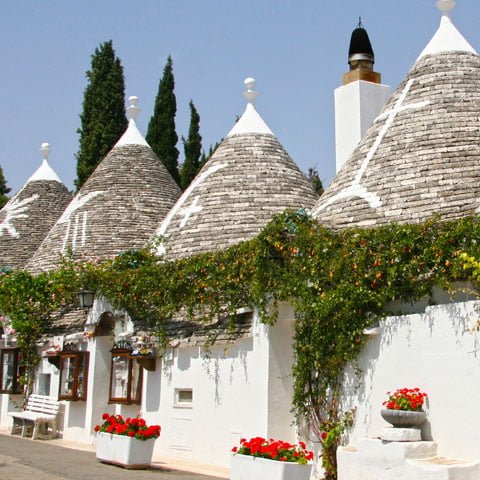
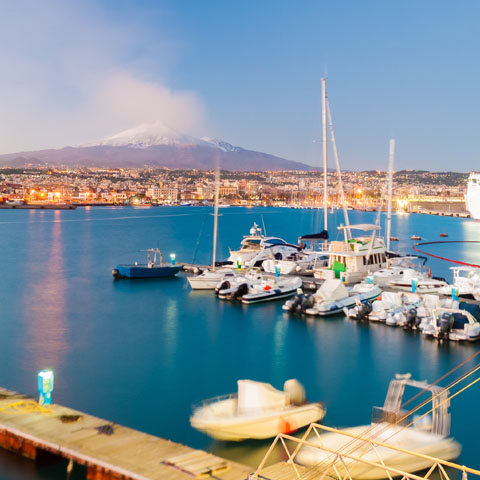
Travel Guides
[wudrelated include="1837"]
About Apulia
[wudrelated include="1840"]
